|
|
This keyboard from 2002 (printed CPU date) employs a unique sounding high fidelity successor of the famous My Music Center sound engine and has lovely electronic accompaniment with special sounding percussion. But like with other Yongmei tablehooters, when new it stank badly of acrid chemicals and makes some polyphony flaws by omitted key matrix diodes. 5 of the keys are fake and simulate drumpads.
Although this is not a 1980th keyboard, it has a very own digital lo-fi pop synth estheticism that nicely differs from all the overused FM and sample stuff. The sound generator is a high fidelity successor of My Music Center; the main sound difference is that it has neither strong zipper noise nor DAC aliasing noise and the 2 subvoices can have each a different envelope and waveform. Although the preset sounds are not natural, they have a great own electronic style because many include a special detuned chorus effect, that turns a little disharmonic and buzzy in the bass range, and some have impulsive clicking percussive attack or odd behaving envelopes. Particular domain of this thing are cold chorused synth strings, sitars, honkytonk pianos and harpsichord sounds, thus I would characterize it best as a digital ice age's equivalent to a string machine. The percussion is made from medium low resolution samples with unusual very bright, loud and hissy cymbals, those make the rhythms sound quite unique. Like with My Music Center, the 5 drumpads can be switched to 5 clear animal voice samples and there is a programmable rhythm pattern (32 steps, including animal voices). Like with early 1980th keyboards, the chord voice can be switched among 4 OBS preset sounds, and there is a nicely archaic sounding fingered chord mode that accepts beside establishment chords also wild disharmonic note combinations. Generally the chords remind to old FM keyboards, but they sounds less hollow, and the rhythm is dominated by these loud and trashy cymbals, those remind to a drunk playing farmer's band on a rural village dance party or the like. It's definitely a great trashy tablehooter with unique sound style. Annoying is that despite analogue volume slider the volume can not be set really low.
(Note: This keyboard sounds great, but don't buy one of these so far your only intention is to get a keyboard with faithfully imitated natural instrument sounds. The timbres have a special synthetic sound estheticism and most sound not remotely like what is written on the control panel, though bought with wrong expectation it may disappoint you. It also needs a modification with much solder work to permit flawless polyphonic play.)
The control panel, electronics and general behaviour of this instrument has many similarities with the ill- designed Yongmei DL-2300. It employs the same type of phthalate- infested soft PVC buttons, although those of my used bought specimen were less sticky and stank less than with my horribly odorous DL-2300. In spite of that it stank still pungent enough that I had to vent it out for some weeks in the bathroom before use. The case is of badly flimsy plastic; with mine the battery compartment rim and entire rear bottom screw row was cracked out after the vendor had left the heavy batteries in the compartment when he mailed it in the original package box. Also a YM-2100 with black control panel was made (colours like my DL-2300, seen on eBay).
 |
 |
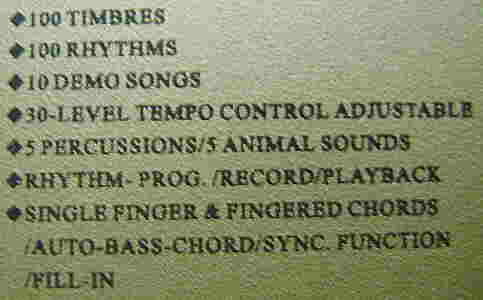 |
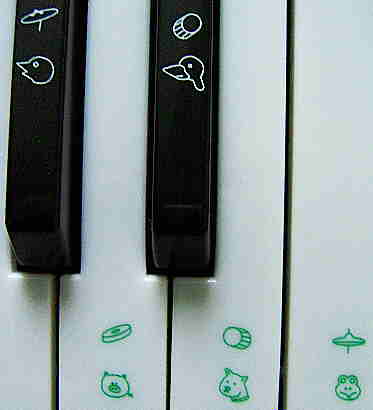 |

 |
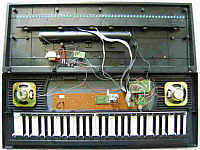 |
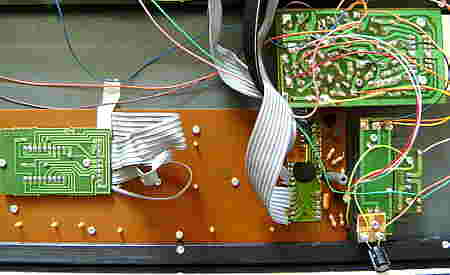 |
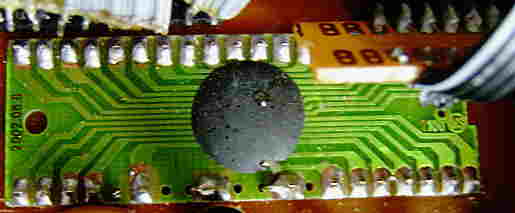 |
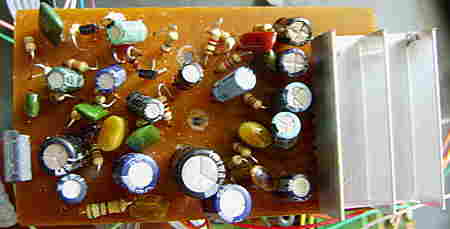 |
 The
keys rumble a little wacky; the rightmost 5 ones are wired parallel with
the drumpad buttons and can not be used for melody play. The reset button
on the control panel may be useful for circuit bending. The general behaviour
of this instrument has similarities with Yongmei
DL-2300, but there are also differences. E.g. the LED display here
indicates less functions (e.g. it ignores when sustain, vibrato or chord
buttons are pressed). Unlike Yongmei DL-2300, the 100 preset sounds
and rhythms here have no fraudulent doublets, but are simply made from
linear combinations of a few internal parameters. But in opposite to the
ridiculously boring sound set of the Bontempi
KS 4600, this one includes also fresh and interesting synth sounds,
because (unlike My Music Center)
here the 2 subvoices can play different envelopes. Annoying is that despite
the sound generator can play up to 8 note polyphonic, by the lack of key
matrix diodes the keyboard adds wrong additional notes when more than 2
keys are pressed. (Upgrading it with 54 diodes is strongly recommended
to make this thing playable, although it will take some hours of solder
work. I haven't modified mine yet and haven't analyzed the hardware closer.) The
keys rumble a little wacky; the rightmost 5 ones are wired parallel with
the drumpad buttons and can not be used for melody play. The reset button
on the control panel may be useful for circuit bending. The general behaviour
of this instrument has similarities with Yongmei
DL-2300, but there are also differences. E.g. the LED display here
indicates less functions (e.g. it ignores when sustain, vibrato or chord
buttons are pressed). Unlike Yongmei DL-2300, the 100 preset sounds
and rhythms here have no fraudulent doublets, but are simply made from
linear combinations of a few internal parameters. But in opposite to the
ridiculously boring sound set of the Bontempi
KS 4600, this one includes also fresh and interesting synth sounds,
because (unlike My Music Center)
here the 2 subvoices can play different envelopes. Annoying is that despite
the sound generator can play up to 8 note polyphonic, by the lack of key
matrix diodes the keyboard adds wrong additional notes when more than 2
keys are pressed. (Upgrading it with 54 diodes is strongly recommended
to make this thing playable, although it will take some hours of solder
work. I haven't modified mine yet and haven't analyzed the hardware closer.) |
The main voice sounds at first hear remind to simple 2 operator FM synthesizer timbres, but in detail they are quite unique. Especially the clear percussive attack phases and the cold detuned chorus effect in many sounds make them interesting, but also the bass range of dull timbres is less hollow, rougher and mildly buzzy. IMO they resemble much certain chorused phase distortion sounds (see Casio CZ-230S), thus before you pay your ass off for a Casio CZ-101, its a good idea first to look for a Yongmei YM-2100 on eBay if you want only that chorus stuff (but diode upgrade is very recommended for polyphonic play). Odd is that the mandolin ring effect stops for a fraction of a second to re-sync when additional note keys are pressed, thus a fast trilled key completely prevents the ring of simultaneously held other notes. Unlike most My Music Center variants, the simultaneous notes here always ring with the same phase; apparently they are re-triggered by a single LFO. The preset sounds follow a systematic naming convention; all sounds with the same name but different number only differ in the waveform but contain the same envelope and chorus setting. Thus like with some old home organs the name only indicates the envelope behaviour and not the timbre itself. Thus you have to look e.g. at "piano" to find guitar sounds.
The "piano" sounds have piano envelope and no chorus (4 resembles a nicely dull Rhodes e-piano). The "organ" sounds have a pipe organ envelope with slightly slow attack and short sustain. "flute" sounds fairly realistic like a metal flute; the bass range is dull and slightly buzzy. "trumpet", "saxophone" and "brass" decay a bit after their slow attack. The "trumpet" timbre is thin and harsh and resembles more a harmonica. "saxophone" resembles a narrow squarewave and "brass" has a dull and semi- hollow timbre like a french horn. The "violin" envelope has a slow attack and a bit of sustain. The "cembalo" behaves bizarre; with held keys it decays faster and never falls completely silent but holds the tone at low volume. "xylophone" is the same with a dull waveform. This is unrealistic but permits nice expressivity. The "mandolin" rings with about 8Hz. The "marimba" decays fast and is not percussive enough; after key release the note stops immediately with a dull popping noise, which sounds very archaic and reminds to my Jörgensen Clavioline. The "bass beat" envelope has nothing to do with its name; its very slow attack phase grows louder during 2 seconds, then it decays slightly quieter and holds the note. Thus it sounds rather like louder fading strings. Beginning with 32 all sounds are made from 2 layered subvoices, which halves the polyphony. All names with "syn" have a detuned chorus that sounds in a special way cold and buzzy with slightly disharmonic howling bass range (like with My Music Center) and constitutes a key feature of this instrument. The disharmonic bass somewhat reminds to the classic Atari POKEY sound style. The 4 "syn piano" sounds are honkytonk pianos made from the "piano" envelope with detuned chorus. The "syn organ" sounds employ the "organ" envelope with the chorus. The same way "syn flute", "syn trumpet", "syn saxophone", "syn mandolin", "syn marimba", "syn xylophone" are those normal sounds with chorus added. Also the 5 "syn brass" sounds have that chorus; all except "1" resemble rather accordion timbres. The "strings" are made from the "violin" envelope with that chorus and have a lovely trashy digital appeal. "syn harp" is the chorused "cembalo". All names with "e." sounds correspond to their "syn" sounds with chorus component not detuned, which makes the bass range less disharmonic, but "e. marimba" is "e. mandolin" with sustain. The "space" sounds have the "bass beat" envelope with detuned chorus. Beginning with number 72 all sounds are made from 2 different layered subvoices. The 8 "syn strings" sounds resemble the "strings", but slowly morph into a slightly different strings timbre during the first 2 seconds. The 4 "piano organ" sounds are made from each a "piano" layered with an "organ" sound, those form a detuned chorus until the piano subvoice decays. The 4 "piano violin" sounds do the same with "violin" subvoice. The "space piano" sound layer each a "piano" with a louder growing "space" sound and thus crossfade to a different timbre, which is a highlight of this instrument. "space harp", "space mandolin", "space marimba" and "space xylophone" also layer "space" with other sounds. The vibrato button adds a 6Hz vibrato and the sustain button 1 second long sustain to the main voice, but they do neither affect held notes nor (unlike Yongmei DL-2300) chord or accompaniment. The transpose +/- buttons otherwise change all main and chord voices in realtime, which can be used as a sound effect (pressing both sets back to 0).
The percussion sample resolution is a bit low and thus sounds slightly distorted. Remarkable are the loud hissing semi- metallic cymbals. The animal voice samples otherwise are rather clear; the "pig" grunts nicely bassy. The custom drummer works similar like with Letron MC-3, but has 32 steps and can record also the animal samples. The user pattern is deleted when notes are recorded into the sequencer. To program a rhythm, press "prog", enter percussion or animal voices with the drumpads (only monophonic) or pause steps with "p. playback". Unlike Yongmei DL-2300 you have to enter a full 32 steps user pattern; although you can finish earlier by pressing "prog" again, this will not shorten the pattern but fill the remaining steps with pauses and thus cause a long space before the pattern repeats. Press "p. playback" to start the programmed rhythm. With accompaniment the chord pattern from the currently selected rhythm is used. (You can still select a different one. Also the fill-in is taken from there.) Starting a preset rhythm does not delete the user pattern, but you have to stop the running rhythm before you can switch to the other. The preset rhythms have each 8 variants ("slow waltz" has only 4), those mostly differ by having additional or changed individual percussion tracks (e.g. loud continuous cymbal), but some have also different accompaniment (e.g. walking bass pattern).
The chord voice of manual chord and accompaniment can be switched between 4 OBS preset sounds. "1" is an e-piano sound with low Hammond organ timbre. "2" is a plain organ timbre that resembles a very dull reed organ or wooden pipe organ rank. After key release the tone stops immediately with a dull popping noise, which reminds to valve noise of a wind operated key instrument. "3" resembles an accordion with slow attack and short sustain; the timbre is a little harsh and thin and may be also a metal fiddle or the like. "4" resembles a dull banjo with not really percussive attack. The automatic accompaniments (with rhythm) contain additionally a monophonic e-bass voice. Switching the chord preset sound or pressing accompaniment volume buttons does not affect held chord notes. The automatic accompaniments employ the same archaic pattern style like DL-2300 (monophonic bass + chopped chord voice), but by the different waveforms they don't sound analogue here. Unfortunately there is no separate rhythm volume control, but you can program a blank user pattern if you only want the accompaniment. Unlike DL-2300, switching rhythms re- starts the pattern immediately, and the fill-in here mutes the accompaniment.
A very bizarre bug makes the (anyway primitive) sequencer unusable; when alternating notes in different octaves are recorded, some of the notes (typically those of higher octaves) are skipped; although they sound correctly during record, they are missing during playback. The sequencer was apparently intended to record even polyphonic, because when you play only within one octave, it records indeed the beginning of additional polyphonic notes, but (unlike the 1st voice) during playback their length becomes always the shortest possible value.
The demo melodies are fairly short and employ a monophonic main voice with standard accompaniment. (I have no manual, but identified them by eBay photos of the technically identical JT-2028.)
The 10 demo melodies are:
An YM-2100 version with slightly different case shape was released as
"JT-2028 - Lucury Computed Electronic Keyboard" (edgier control
panel shape, more systematically sorted sound & rhythm list, omitted
"timbre/ rhythm" button ( = wired parallel to "perc/ animal"?), seen on
eBay);
the strange misspelled name strongly hints to the manufacturer
Jin
Xin Toys (see JX-20165).
A direct predecessor of the YM-2100 hardware class was likely the Miles
MLS-4900A; a successor was likely the Yongmei
DL-2300. A YM-2100 in a cyan DL-2300 case (black control panel
with same sound list layout) was released as Yongmei YM-2300 (seen
on Yongmei site). Likely a midsize
YM-2100 version was released as Super Sound Brand - SBS EK-906 (case
like Superb Sound EK-905,
seen on eBay). Another quite professional My
Music Center successor was the Elta-
EK-491 (49 midsize keys with even a simple synthesizer and MIDI-
out).
| removal of these screws voids warranty... | ||
 |
||
|
|